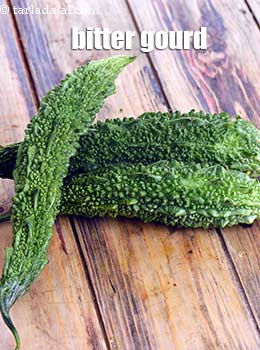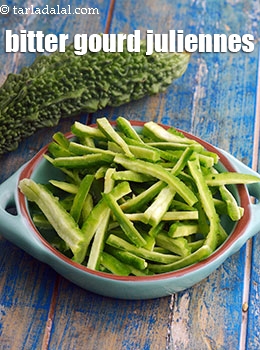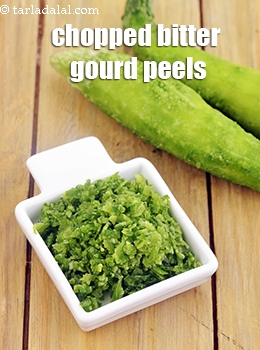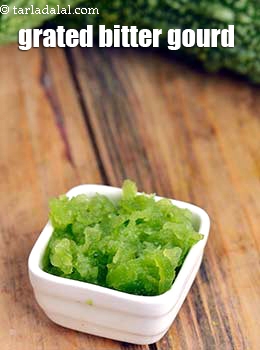
Also known as
Karela, Bitter melon.
What is Karela, Bitter Gourd, Bitter Melon?
Momordica charantia is a tropical and subtropical vine of the family Cucurbitaceae, widely grown for edible fruit, which is among the most bitter of all vegetables. English names for the plant and its fruit include bitter melon or bitter gourd. The fruit has a distinct warty looking exterior and an oblong shape. It is hollow in cross-section, with a relatively thin layer of flesh surrounding a central seed cavity filled with large flat seeds and pith. Seeds and pith appear white in unripe fruits, ripening to red; they are not intensely bitter and can be removed before cooking. The flesh is crunchy and watery in texture, similar to cucumber, chayote or green bell pepper. The skin is tender and edible. The fruit is most often eaten green. The bitter melon more typical of India has a narrower shape with pointed ends, and a surface covered with jagged, triangular "teeth" and ridges.
Bitter gourd halves

Wash the bitter gourd thoroughly with water and dry using a kitchen towel. Then place the bitter gourd on a chopping board and cut off the stem. Then cut it into 2 halves lengthwise using a sharp knife.
Bitter gourd juliennes

Wash the bitter gourd thoroughly with water and dry using a kitchen towel. Then place the bitter gourd on a chopping board and cut off the stem. Then cut it into 2 halves lengthwise using a sharp knife. Place a halve on the chopping board flat and slice it by cutting horizontally (parallel to the chopping board) into thin slices. On each slice, make vertical slits at regular intervals (1/4 inch in diameter) using a sharp knife. Line all the strips together and cut at regular intervals horizontally to form 2 inch long juliennes. This is best used for deep-frying and stir-frying.
Bitter gourd peels

Wash the bitter gourd thoroughly with water and dry using a kitchen towel. Then place the bitter gourd on a chopping board and cut off the stem. Using a peeler, peel it. The peels can be later used in soups or therapeutic stews.
Bitter gourd slices

Wash the bitter gourd thoroughly with water and dry using a kitchen towel. Then place the bitter gourd on a chopping board and cut off the stem. Cut at regular intervals using a sharp knife across the chopping board to get bitter gourd slices. You can slice them thinly or thickly as per the recipe requirement.
Chopped bitter gourd

Wash the bitter gourd thoroughly with water and dry using a kitchen towel. Then place the bitter gourd on a chopping board and cut off the stem. Then cut it into 2 halves lengthwise using a sharp knife and scrape out the seeds with a sharp spoon or corer and discard them. Place one halve on the chopping board and make vertical slits at regular intervals using a sharp knife. Line all the long pieces together and make horizontal slits at regular intervals. You can cut them finely or roughly as per the recipe requirement.
Chopped bitter gourd peels

Wash the bitter gourd thoroughly with water and dry using a kitchen towel. Then place the bitter gourd on a chopping board and cut off the stem. Using a peeler, peel it. Place the peels on a chopping board and chop them using a sharp knife.
Grated bitter gourd

Wash the bitter gourd thoroughly with water and dry using a kitchen towel. Then place the bitter gourd on a chopping board and cut off the stem. Hold the thick/ thin end of the grater in one hand and the bitter gourd in the other hand. Now place the bitter gourd on the blade and push it downwards using the force of your hands to get grated strands of bitter gourd. You can grate it thickly or thinly as per the recipe requirement.
Sliced bitter gourd

Wash the bitter gourd thoroughly with water and dry using a kitchen towel. Then place the bitter gourd on a chopping board and cut off the stem. Then cut it into 2 halves lengthwise using a sharp knife and scrape out the seeds with a sharp spoon or corer and discard them. Place one halve on the chopping board and cut them into thick or thin slices by cutting across the chopping board.
How to select Karela, Bitter Gourd, Bitter Melon
Young immature bitter gourds are the best for cooking: the skin is bright green in color, the flesh inside is white, and the seeds are small and tender. The vegetable is ridged, and the skin is pebbly in texture. Do not use mature bitter gourds as they tend to be more bitter. Although it can also be eaten when it has started to ripen and turn yellowish, it becomes more bitter as it ripens. The fully ripe fruit turns orange and mushy, is too bitter to eat, and splits into segments which curl back dramatically to expose seeds covered in bright red.
Culinary uses of Karela, Bitter Gourd, Bitter Melon in Indian cooking
healthy bitter gourd recipes. Even though disliked by almost all,
karela has a lot of vitamins and also certain minerals like
iron,
copper and
potassium which makes it a great option for
diabetics to have.
Karela tikkis are one such healthy option. These
tikkis are made with peas, low fat paneer and other veggies, cooked in very little oil, making it really healthy. It is essential that we have
juices in our diet but no one really thinks of
Karela juice. It is super simple to make – just blend it, strain it and season with lemon juice and salt and you're good to go!
Karela Tikkis with Kadhai Chole makes two unique combinations go excellently together. Here, the simplicity of the tikkis is balanced by the spicy
chole flavored with ginger, garlic and even
amchoor. With different variations of bitter gourd coming to mind, one of my absolute favorite ones is
Karela Thepla. A dough flavored with bitter gourd, garlic and
Indian spices makes delicious and healthy
theplas!
· In the cuisines of South Asia and the West Indies, it is often prepared with potatoes and served with yogurt on the side to offset the bitterness, or used in subzis.
· In Punjabi cuisine, bitter melon is stuffed with spices and then fried in oil
· In the cuisine of South Indian state of Kerala, for making a dish called thoran mixed with grated coconut, theeyal and pachaadi
· In Andhra Pradesh, the popular recipes include curry, deep fry with peanuts (ground nuts), 'Pachi Pulusu' ( a kind of soup made up of boiled Bitter Melon, fried onions and other spices)
· Bitter gourd juice is a popular health drink, especially for diabetics.
· In Indonesia, bitter melon is prepared in various dishes, such as stir fry, cooked in coconut milk, or steamed.
How to store Karela, Bitter Gourd, Bitter Melon
To store bitter gourd, wash and dry them gently and place them in bags. They should last a week, when stored in refrigerator at 50° F. Both the fruit and the juice freeze well.
Nutritive Information for Bitter gourd (karela):
1 Cup of chopped bitter gourd is about 112 grams
RDA stands for Recommended Daily Allowance.
Energy - 28 calories
Protein – 1.8 g
Carbohydrate – 4.7 g
Fat – 0.91 g
Fiber – 4.8 g
Vitamins:
0.08 mg of Vitamin B1 (Thiamine) = 5% of RDA ( (about 1.2 to 1.6 mg for men)
0.1 mg of Vitamin B2 (Riboflavin) = 5.3% of RDA (about 1.4 to 1.9 mg for men)
0.56 mg of Vitamin B3 (Niacin) = 4.7 % of RDA (about 12 mg)
98.5 mg of Vitamin C = 246.4% of RDA (about 40 mg)
141.1 mcg of Vitamin A = 2.9% of RDA (about 4800 mcg)
Minerals:
22.4 mg of Calcium = 2.2% of RDA (about 1000 mg)
0.68 mg of Iron = 3.4% of RDA (about 20 mg)
40.3 mg of Magnesium = 11.5% of RDA (about 350 mg)
78.4 mg of Phosphorus = 13.1% of RDA (about 600 mg)
0.43 mg of Zinc = 3.6% of RDA (about 10 to 12 mg)
191.5 mg of Potassium = 4.1% of RDA (about 4700 g)
9 Health Benefits of Karela, Bitter gourd, Bitter Melon
Like Tulsi juice, a glass of karle juice is often recommended for good health. True to the fact, karela benefits us right from managing diabetes to strengthening our immune system to reducing body inflammation, purifying blood to promoting weight loss. Have a quick look at all well-known benefits of not-so popular karela.
1. Manage Diabetes : This is one of the most crucial health benefit known to all. Anyone who has just been detected with diabetes is advised to eat karela by all – be it a family member or a friend. Many studies have shown that they contain insulin like substances which help to keep blood sugar under control. Moreover the carb count of this gourd is also low, which is an added advantage for diabetics. The seeds and the juice of karela both are beneficial. If you want to opt for juice, try and drink a small glass on an empty stomach in the morning or it is best had in-between meals. Want to include karela in your meals? We have tried and tested recipes like Karela Theplas, Karela Tikkis and Karela Muthias just for you. These recipe have been crafted keeping in minds all the other necessary nutrients required to plan a diabetic meal.
2. Improve Gut Health : Regular consumption of karela has a very positive effect on digestive health. It not only reduces intestinal disorders like constipation but is equally beneficial for Irritable Bowel Syndrome (IBS) by helping to treat the parasites that enter the digestive system. Its high fiber count and natural laxative property is what aids digestive health. The antioxidants in the juice are also known to stimulate the digestive enzymes and promote digestion.
Click here to know more about the 9 Health Benefits of Karela (Bitter gourd).